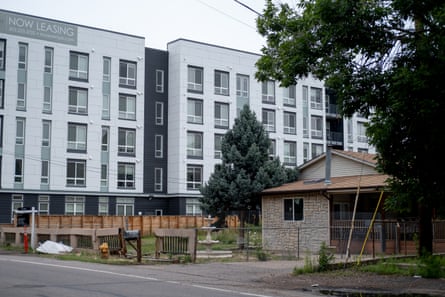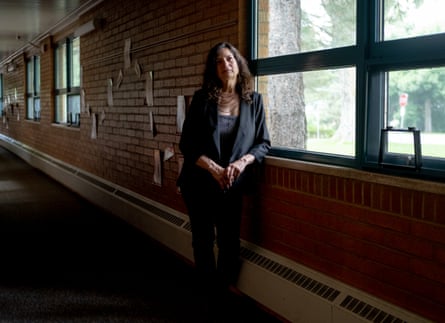
In 2017, Stephanie Deveaux noticed her city and neighborhood were changing. Lying on Denver’s western outskirts, Lakewood was known for its spacious single-family homes, good public schools, pristine parks and Rocky Mountain views. But many of the things that made Lakewood so livable seemed under threat.
“All these multiunit dwellings [were] starting to be developed,” she said, referring to the boxy, ultramodern and monotone buildings now scattered across Lakewood. “And then lands that I thought had been earmarked for open space, those started to get filled up.”
Cathy Kentner, a teacher and Lakewood planning commission member, also noticed those same tall buildings “adjacent to small single-family homes and cutting off all their sunlight”; deteriorating streets; busier hospitals; and green space being replaced by “a sea of concrete”. She mentioned the murals dotting several buildings along West Colfax Avenue as an example. “I really appreciate the art that they put on the outside, how it’s all green and plants,” she said. “[But] how nice would it be to actually have some real greenery.”

Kentner, Deveaux and other residents wondered if they could slow Lakewood’s growth and preserve, as if in amber, affordable housing and all their community’s beloved qualities. They argued developers were raising housing costs across the board, while doing little to maintain the parks, roads and schools that made Lakewood such a great place to live. Ultimately, they campaigned for a municipal Strategic Growth Initiative (SGI), which limited new construction in the city to 1% of the previous year’s housing stock. Buildings with more than 40 units needed to go through public hearings before approval.
Growth caps like Lakewood’s can have notoriously uneven results, sometimes cutting housing supply and raising costs even when the goal is to lower them. Such impacts are partly why, in June, Colorado’s governor signed a new state law prohibiting cities from explicitly limiting population growth or the number of residential units that can be approved; taking effect this month, the measure aims to lessen the “irreparable economic harm to working-class Coloradans” they can sometimes cause. It leaves Lakewood and other Colorado cities in limbo, wondering whether their policies will be overturned and, more importantly, what they can do to keep housing costs low and costs of living high.
In Lakewood, housing prices keep rising. Single-family house prices have skyrocketed 94% since 2015, from $370,000 to almost $716,000. Average apartment rental prices now range from $1,704 to $1,833 depending on the neighborhood, representing an annual increase of 5% to 6% since 2017. Most renters are also paying more than they can afford: currently, 58% of all renters spend more than 30% of their income on housing. That makes them “cost-burdened” and less able to comfortably support themselves.

In Lakewood, Kentner observed it’s not just the cost of housing that’s a barrier. It’s what kind of housing gets built in the first place. Over the last 20 years, two-thirds of all new residential construction in Lakewood has been multifamily structures: apartment and condo complexes, duplexes, townhomes. As Lakewood’s housing stock has shifted, its households have also shrunk: nearly 75% now contain only one or two residents. The number of families with children in Lakewood declined, and next year, Lakewood will close five of its public schools.
Kentner attributes these trends to the growing scarcity of affordable single-family homes. “The starter homes for people, the smaller ones that are a little older, are being torn down and replaced by these multifamily structures that don’t attract young families,” she said.
It’s not clear if this type of new development is driving young families out of Lakewood or if they were already on the decline. But there are undeniable demographic shifts; the population now skews toward millennials between 25 and 34 and retirees over the age of 65.
“It’s working in both directions,” said Joseph Gyourko, professor of real estate and business economics at the University of Pennsylvania’s Wharton School of Business. “Development can change demographics if it’s big enough. … But there’s so many other factors that influence that.”
Since it was implemented in 2020, Lakewood’s growth cap hasn’t curbed housing starts. “Our strategic growth initiative was never implemented as intended,” said Kentner. Developers used exemptions for redevelopment of blighted property or the replacement of existing units. Those exceptions pushed residential growth over the permitted numbers. In its first year, the ordinance allowed up to 693 units to be added. Of these, only 184 residential building allocations were issued, but another 654 units were built under various exemptions.

A growth cap played out similarly in Boulder, some 35 miles away. There, the cap was implemented stringently enough in its early years to significantly slow the rate of new construction and push growth to surrounding cities. But more recently, exemptions for certain types of new construction – in mixed-use buildings, areas rezoned from nonresidential purposes – have meant that the cap is no longer constraining growth.
John D Landis, professor emeritus of city and regional planning at the University of Pennsylvania, has studied growth caps over the past 50 years. He pointed out that their effects are highly contextual. Growth caps have largely failed at slowing growth and instead made housing more expensive – with some variations.
“Housing development is pretty cyclical. So some years the caps would be constraining, and other years they would not be,” he said. In California, where the ’70s and ’80s brought caps in coastal metropolitan areas, Landis found only small differences in rates of new construction between cities that had caps and their neighbors that didn’t.
Elizabeth Peetz with the Colorado Association of Realtors – which donated $25,000 to defeat Lakewood’s SGI – warned the cap could worsen affordability. “There will be unintended consequences for current and potential homeowners: increases in property taxes for existing homeowners, rising rents, and fewer affordable options for potential future homeowners,” she told 5280 magazine in 2019.
But Landis said “the amount that housing prices have gone up has varied tremendously, depending on whether the city or the community next door had a similar cap. Whenever the adoption of a growth cap inspired an adjacent city to adopt a similar measure – usually from fear of receiving the spillover from their neighbor – significant increases in housing costs followed.
And with those higher prices come wealthier neighbors who drive more and use more services. So crowding and infrastructure wear and tear can go up even as housing development goes down. Caps can also be associated with declining populations of Black and Latino/a residents, though Deveaux insisted that’s not the case with the SGI. “It’s not to cherry pick the kind of residents that we have,” she said.

In Colorado, Boulder and Golden, which has also had a similar growth cap in place for years, are among the state’s most expensive places to live. Median home prices range from $978,000 in Golden to $1.5M in Boulder. Campaigns for growth restrictions are also underway in the ski town of Aspen (which tries to limit new development by square footage) and the suburb of Englewood (where petitions are circulating to fire city council members who considered allowing multifamily residences in single-family zoning areas). It remains to be seen whether these efforts, which limit growth without explicitly restricting population or the units built, will survive under the new state law.
The experiences of both California and Colorado suggest that growth caps generally don’t work to address the harms of rapid development.
Instead, other mechanisms can address the concerns that draw residents to growth caps. Kentner acknowledged inclusionary zoning as another, more evidence-backed path to affordability. Such policies require developers to make a certain percentage of new units affordable. Though outcomes depend heavily on policy design, in southern California, inclusionary zoning produced as many affordable units as the Low Income Housing Tax Credit (LIHTC), the country’s largest housing subsidy program. Denver also instituted inclusionary zoning in 2022.
To avoid overburdened infrastructure, Landis pointed to adequate public facilities ordinances, which allow new construction so long as there is available capacity in the community’s roads, parks and schools. When that room starts to run out, developers can contribute to a fund to expand that capacity and continue building. Another strategy could be to raise the fees paid by developers, which then go into the city tax base to offset the costs of growth. Lastly, urban growth boundaries can restrict high-density development to specific areas, which can help reduce sprawl, traffic congestion, and road wear and tear.

In late July, Lakewood’s city attorney presented a draft emergency ordinance that would temporarily exempt the city from the new state law and keep the SGI in place for another two years. City officials say they need time to create new land use laws in compliance with the state bill, and the city council will discuss the ordinance on 7 August.
Kentner seems resigned to the SGI’s eventual overturning. But she said, “Our initiative was really a cry to our elected officials to please do something about development that is causing displacement of families, and not building the housing that we need, and [creating a] lack of open space.”
Gyourko also does not believe the overturning of Lakewood’s cap will fling the gates to growth wide open. “You can restrict and prevent development in an incredibly diverse number of ways,” he said. “You could do it through zoning, you can do it through environmental regulation, you can do it in public health regulation.”
At the same time, he thinks communities that allow development should be subsidized by state or federal governments. “[If] you’re truly fearful that your roads will get clogged, we’ll provide funds for roads,” he offers up as an example. Without such “payoffs”, existing residents will keep fighting to preserve their neighborhoods and cities as they once were – and will likely never be again.










 English (US)
English (US)